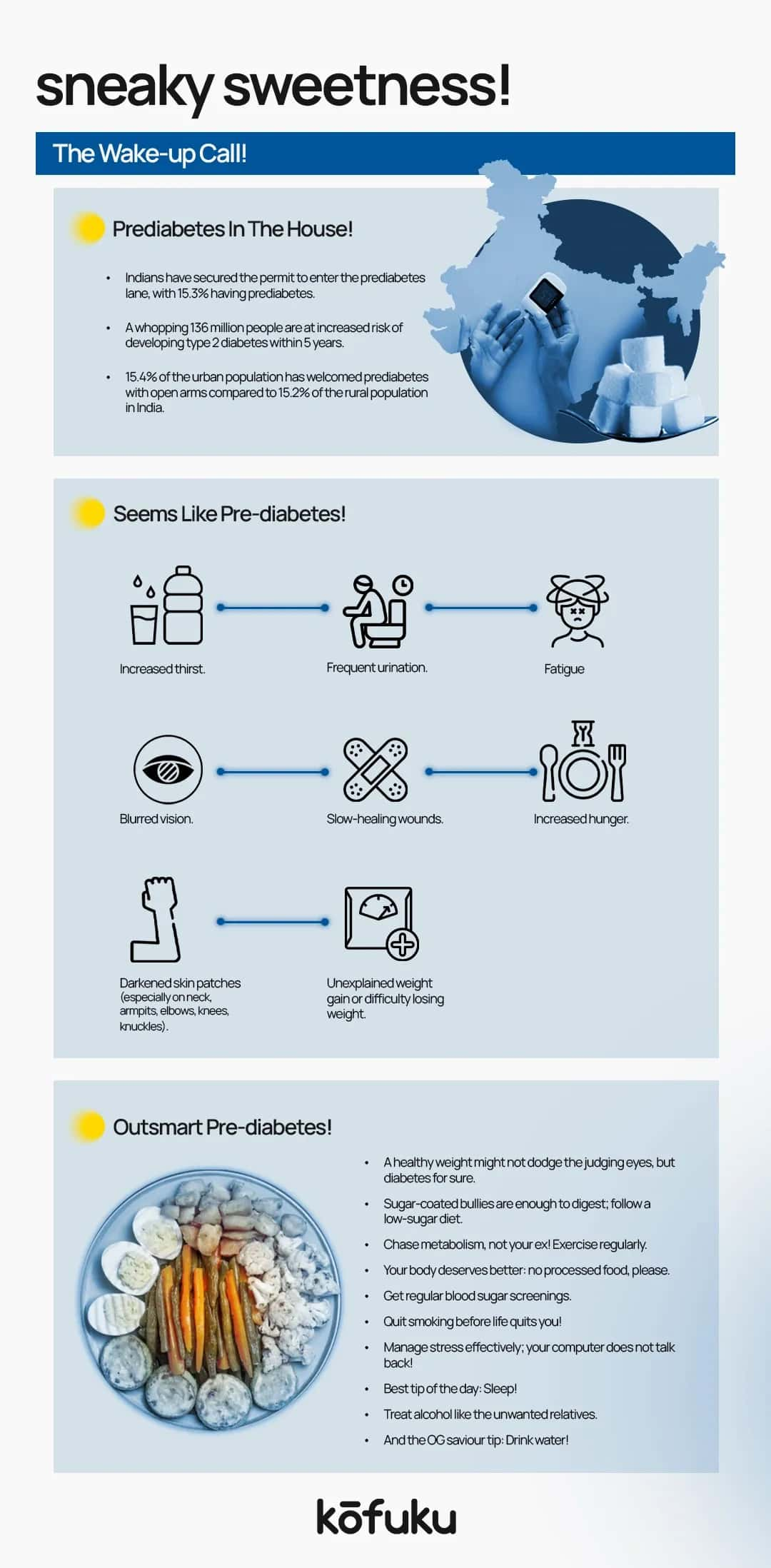What Really is Prediabetes?

Introduction
Imagine standing on the cusp of diabetes, waiting to dive into the sea of lifestyle diseases. Like staring into the abyss with blood sugar levels so high, you know you’re pushing the envelope, but you’re loath to do anything about it.
That’s the thing with people. For us, warning signs are like reminders. We see higher than usual levels of blood sugar, and instead of clamping down on it, we shut it out of our system, continuing to live the unhealthy, hedonistic lifestyle that has brought us here in the first place.
Prediabetic blood sugar levels between 100-125 mg/dL (5.6-6.9 mmol/L) for fasting blood sugar tests, or 140-199 mg/dL (7.8-11.0 mmol/L) for two-hour post-glucose load tests? Let’s slam a jam-filled sugary doughnut after lunch, and sit for a 2-hour meeting digesting it.
Perfect way to borderline that blood sugar while we’re at it, right? WRONG. Pre-diabetes is a sign! Read the signs, don’t be blind.
What Really Is Prediabetes?
This rather grim term means that your blood sugar, also known as blood glucose levels, is higher than normal. If that reaches a certain level, it’s game over - you have diabetes. Why does this happen? It is a sign that your body is not utilising insulin properly. This causes a build-up of glucose in the blood. If that carries on unchecked, the results are disastrous.
Prediabetes - when your blood glucose levels are high, but not high enough to be termed as diabetes. Call it the precursor to Type 2 diabetes. If you are prediabetic, you are at a much higher risk of developing Type 2 diabetes. Heart disease and heart attack will follow suit soon.
Having pre-diabetes means you cannot postpone the onset of full-blown type 2 diabetes by making some basic lifestyle changes. Eat healthy, ensure your body weight is optimum and don’t skip on that exercise.
Symptoms of Prediabetes
There are no other symptoms of this condition except having elevated levels of blood sugar. If you are doubtful, get your blood sugar tested. The results can assuage your anxiety. Or increase it, depending on what the numbers are. There are some subtle signs and symptoms of prediabetes.
Different symptoms of pre-diabetes :
-
Craving water.
-
Urinating rather frequently.
-
Low energy or fatigue.
-
Can’t see. Hazy.
-
Sores that don’t heal, regular infections.
-
Unsightly, dark skin patches on the armpits, neck, elbows, knuckles or knees (a condition that is known as acanthosis nigricans)

How do we diagnose prediabetes? What Do We Have To Watch Out For?
If you are 45 years old, or more, you should get tested. People younger than 45, this is not a sign to enjoy. Get tested, and be sure of your blood sugar levels. Don’t second-guess them, because you cannot fool the doctor.
Your doctor can prescribe a litany of tests to check for prediabetes. He/she may want your “fasting blood sugar” numbers. This is your blood sugar level before anything enters your stomach in the morning. Some sample ranges for the results of a fasting blood sugar test are -
Normal - between 70 and 99 mg per dL.
Prediabetes - between 100 and 125 mg per dL.
Diabetes - more than 126 mg per dL.
Your doctor might also prescribe an A1C blood test. This test highlights your average blood sugar levels over the past quarter. The results are reported as follows, as a percentage.
Normal - below 5.7%
Prediabetes - between 5.7% and 6.4%
Diabetes - 6.5% or more.
The A1C blood test gives information about the average levels of blood glucose, also known as blood sugar, over the past 3 months. This A1C test is great for diagnosing type 2 diabetes and prediabetes. This test also happens to be the primary test for diabetes management.
This test has several names. It is known as the hemoglobin A1C, HbA1c, glycated hemoglobin of glycohemoglobin test. Hemoglobin is that bit of a red blood cell that ferries oxygen to the cells. Glucose attaches to this hemoglobin in your blood cells and the A1C test is all about attachment of glucose to hemoglobin.
The more glucose you have in your bloodstream, the more will attach to the hemoglobin. The A1C test will determine the amount of hemoglobin with attached glucose and shows us your average blood glucose levels over the past quarter.
This A1C test gets reported as a percentage. The more the number, the more are your blood glucose levels. A normal A1C level is less than 5.7 percent. Anything more, is time to hit that alarm button.
Can I Prevent Pre-Diabetes and Diabetes as a Result?
Yes, you can dodge the bullet. Nothing that has been damaged is beyond repair, even your body. There are certain small but highly important lifestyle changes that you need to incorporate into your life. If you are fat, stop being fat.
Eat healthy. Exercise regularly, don’t sit sedentarily. Remember - the longer that you have prediabetes, or diabetes, the floodgates of health problems will remain open. Delaying or preventing the onset of this disease can do wonders for your health.
How do I keep diabetes away?
Lifestyle changes are your best friend.
Lose weight
If you are overweight, the bad news. Time to shred. Drop at least 7% of your starting weight. This is the best way to delay or prevent diabetes altogether. If you weigh around 200 pounds, lose 14 - that can make a big difference. Also your reduced blood pressures and cholesterol levels will thank you.
Workout, Workout, Workout
When it comes to diabetes prevention, exercise is king. You should have a workout routine that has 30 minutes of moderate physical activity, at least 5 times. Brisk walking, cycling, swimming - everything works. Speak to your doctor and determine what your optimum exercise levels are.
Eat Healthy
Vegetables should be your best friend. Fruits, whole grains, and lean proteins, like chicken or fish, and low-fat dairy products. Steer clear of processed, sugary or fried foods. Cut down your portions, to reduce the number of calories you’re ingesting everyday. And stay away from carbonated beverages. Those are poisonous.

Okay, I Don’t Want Prediabetes- How Do I Get Rid of It?
No one wants prediabetes, anymore than they want herpes. The diktat is simple - lose weight, exercise, and eat healthy - these are the three things that you can do to help control your blood sugar levels and prevent them from skyrocketing.
If you’re lucky, you might see a decrease in blood sugar levels. You can even reverse prediabetes, if your lifestyle changes are on point.
Okay, there are medicines, but they’re not as effective as diet and exercise. However, your doctor might decide to go the pharmaceutical route if you are at high risk for diabetes or exhibit other medical issues.
These could be anything from obesity, a low HDL cholesterol level, an increased triglyceride level and high blood pressure.
Living With Prediabetes
Whoa, we're halfway there. Whoa-oh, livin' on a prayer
Bon Jovi sure knew something was up. If you have prediabetes, your focus should be on preventing full-blown diabetes. All you have to do is lose weight, eat right and exercise regularly. These lifestyle changes are easier said than done. Here are some tips for success.
Baby Steps, Amigo
You think lifestyle changes are easy? Try replacing potato chips with boiled vegetables and you’ll understand. However, all changes aren’t required at once. Start small - ditch soda and drink water - track your progress.
Then tackle another change, and keep moving forward. Your lifestyle will continue improving, as will your health. Weight loss or not, such lifestyle changes can definitely make you healthier.
Setbacks? Tackle Them
Newsflash - nobody’s perfect. Sliding into old habits is easy. If you have a setback, don’t dwell on it. Move back to your healthy habits without wasting time. Taking a step backwards is fine, as long as you don’t stop moving forward. Your health will get better automatically.
Support Is Your Best Friend
Doing things by yourself is not easy. Find other people who are attempting the same lifestyle changes for encouragement and new ideas for you to try, as long as you support each other. This will make you more accountable for the decisions you make. Ever tried skipping a workout when you have a gym buddy waiting for you? It’s impossible.
Educate Educate, Educate
Make healthier food decisions at the grocery store, when dining out and in the kitchen. The more knowledge you have about how food works in the body, and what you need to be eating it gets easier to make healthy lifestyle choices for yourself.
Doctors might tell you to undergo nutritional counselling, or a dietitian visit. Such stems can help you ditch your old habits and live healthier.
The Big Picture
It can get hard to make day-to-day decisions. However, in the long run, they add up to make you a healthier person. Prediabetes can be controlled, and even reversed, if you have focus, and make good lifestyle choices. Go on, change your life, one step at a time.
Conclusion
Don’t ignore this warning sign if your blood sugar levels are higher than normal, but not high enough for a diabetes diagnosis. Let it be untouched, and it can progress to type 2 diabetes.
It could also expose you to heart disease and stroke. If you want to reverse prediabetes, with lifestyle changes like eating healthy, weight management and exercise, you can do so. Early awareness and action are important for long-term health and well-being.
FAQs
Q. What causes prediabetes?
A. Prediabetes is primarily caused by insulin resistance, where your body doesn't use insulin effectively. Risk factors include being overweight, having a sedentary lifestyle, poor diet, and a family history of diabetes.
Q. Can prediabetes be reversed?
A. Yes, in many cases, prediabetes can be reversed through lifestyle changes.
Q. What are the symptoms of prediabetes?
A. Prediabetes often has no clear symptoms. Some people may experience increased thirst, frequent urination, or fatigue, but many only find out through a blood test.
Q. How is prediabetes diagnosed?
A. Prediabetes is usually diagnosed with blood tests such as the fasting blood sugar test, Hba1c test, or an oral glucose tolerance test (OGTT).
Q. Who is at risk for prediabetes?
A. You’re at higher risk if you’re over 45, overweight, physically inactive, have high blood pressure or cholesterol, or have a family history of type 2 diabetes.






